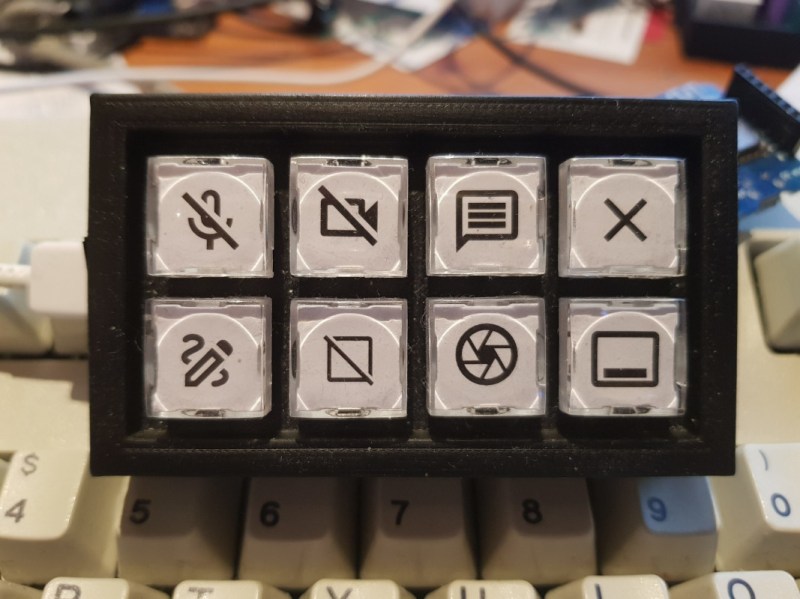From the smallest 60% keyboards for those with no desk space to keyboards with number pads for those doing data entry all day, there’s a keyboard size and shape for just about everyone. The only problem, even with the largest keyboards, is that they’re still fairly limited in what they can do. If you find yourself wishing for even more functionality, you might want to build something like this custom macro keyboard with built-in LED backlighting.
Rather than go with a standard mechanical keyboard switch like a Cherry MX, this build is based around TS26-2 pushbuttons with built-in LED lighting. [atkaper] only really needed one button for managing the mute button on MS Teams, but still built a total of eight switches into this keyboard which can all be individually programmed with different functions. The controller is an Arduino Leonardo and the enclosure was 3D printed.
Paired with the classic IBM Model M keyboard, this new macro keyboard adds plenty of functionality while also having control over LED backlighting. Macro keyboards are incredibly useful, especially with their ability to easily change function with control over the software that runs on them. The key to most builds is the 32U4 chip found in some Atmel microcontrollers which allows it to easily pass keyboard (and mouse) functionality to any computer its plugged in to.















create small keyboard is easy because gpio is big
how create big keyboard with 250 keys?
A 16×16 keyboard matrix.
Plus patience while coping with more then two hunderd keys.
To get to 250 keys, you can for example use 4 serial to parallel chips like this: 74HC595 (see https://components101.com/ics/74hc595-shift-register-pinout-datasheet ) to get 32 matrix output column lines. This takes just 3 pins from the micro controller, as those chips can all be chained together. Then use 8 more micro controller lines for reading the matrix rows. This gives a max of 256 keys, and leaves 5 controller lines open for other functions. Perhaps for adding more serial to parallel chips to drive some leds? Or just connect a chained bunch of ws2812 rgb leds on a single pin for led lights.
But for a big size like that, I would opt for designing a printed circuit board, and use normal keyboard keys.
Hey, that looks like https://www.crowdsupply.com/anavi-technology/anavi-macro-pad-8
nice find! is this one good, does anybody have experinces with it? goes for 44 bucks.
Very nice. What is the symbol with the square with the line through it?
No squares, man.
That cat ain’t gonna dig, man. He’s like perpendicular parallel pairs.
The pencil button to the left of the crossed square can be used to draw / doodle on the screen (overlay on anything you see). The crossed square clears those screen doodles / drawings. The shutter button to the right of that square takes a region screenshot. Those three buttons are the ones I used most in my daily work ;-) → see something which is not OK (or is just altered by me, and is OK), or requires someones feedback or input, circle it using the pencil (or underline / point an arrow), screenshot + send, and clear screen using the crossed square.
How about attaching OLEDs to each key?
https://youtube.com/shorts/tc_CCJnX4GA?feature=share